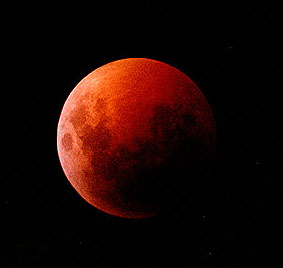WAITING FOR THE
SHADOW
SOLAR AND LUNAR ECLIPSE OBSERVING |
|
|
|
|
|
|
|
|
|
 Artistic impression of the appearance of the eclipsed Moon as it becomes visible during twilight. |
Upcoming events in the night sky Joe Cali
April sees two interesting
transient eclipse type events both occuring mid-month. On Tuesday April
15th, 2014, eastern Australia will see the last half of a total lunar
eclipse occuring as the Moon rises at sunset. The event will only
become visible as twilight causes considerable darkening of the night
sky. Two days later at 4am on the morning of Thursday Venus will occult (pass in front of) the relatively bright start Lambda Aquarii (magnitude 3.7). This is not visible to the naked eye or binoculars. The disappearance will be lost in the bright glare of the Venutian atmosphere but the reappearance should be relatively easy in any small decent quality telescope. Next Month on May 14, Saturn will be occulted by the Moon. Total lunar eclipse on April 15 On Tuesday April 15 a total lunar eclipse will be visible during and after evening twilight. A lunar eclipse occurs at certain full moons when the Moon passage through the Earth's orbital plane corresponds exactly at full moon. Being full moon, the Moon rises as the sun sets. Totality is in progress as the Moon rises. A totally eclipsed moon will not be visible at sunset but as twilight sets in, the coppery red moon will progressively become more visible against the deep blue sky on the eastern horizon. Whilst not ideal for astronomical observations, eclipses like this are aesthetically beautiful to watch as the coppery Moon magically appears out of the darkening twilight sky. Lunar eclipses vary in brightness. This is usually related to how deep into the umbra the Moon passes during the eclipse. As can be seen in the umbral passage diagram below, the limb of the moon does not go very deep into the umbra. At a guess, the brighter limb of the totally eclipsed Moon will begin to show up around the time of civil twilight. |



| EVENT Totality begins (U2) Moonrise Sunset Civil Twilight Totality ends (U3) Astronomical Twilight |
TIME [EST] 17:07 17:35 1740 18:06 18:25 19:05 |
VISIBILITY OF MOON Totally eclipsed Moon not visible Totally eclipsed Moon not visible Totally eclipsed Moon not visible Totally eclipsed Moon partly visible Totally eclipsed Moon visible Partially eclipsed Moon visible |
| EVENT Totality begins (U2) Moonrise Sunset Civil Twilight Totality ends (U3) Astronomical Twilight |
TIME [EST] 17:07 17:23 17:28 17:52 18:25 18:47 |
VISIBILITY OF MOON Totally eclipsed Moon not visible Totally eclipsed Moon not visible Totally eclipsed Moon not visible Totally eclipsed Moon barely visible Totally eclipsed Moon visible Partially eclipsed Moon visible |
| EVENT Totality begins (U2) Moonrise Sunset Civil Twilight Totality ends (U3) Astronomical Twilight |
TIME [EST] 17:07 17:28 17:33 17:58 18:25 18:56 |
VISIBILITY OF MOON Totally eclipsed Moon not visible Totally eclipsed Moon not visible Totally eclipsed Moon not visible Totally eclipsed Moon barely visible Totally eclipsed Moon visible Partially eclipsed Moon visible |
| EVENT Totality begins (U2) Moonrise Sunset Civil Twilight Totality ends (U3) Astronomical Twilight |
TIME [EST] 17:07 17:49 17:54 18: 21 18:25 19:22 |
VISIBILITY OF MOON Totally eclipsed Moon not visible Totally eclipsed Moon not visible Totally eclipsed Moon not visible Totally eclipsed Moon barely visible Totally eclipsed Moon visible Partially eclipsed Moon visible |
| EVENT Totality begins (U2) Moonrise Sunset Civil Twilight Totality ends (U3) Astronomical Twilight |
TIME [EST] 17:07 17:26 17:32 17:55 18:25 18:49 |
VISIBILITY OF MOON Totally eclipsed Moon not visible Totally eclipsed Moon not visible Totally eclipsed Moon not visible Totally eclipsed Moon barely visible Totally eclipsed Moon visible Partially eclipsed Moon visible |



| Event | Shutter Speed | Aperture |
| Full Moon Penumbral Eclipse Moon 1/4 eclipsed Moon 1/2 eclipsed Moon 3/4 eclipsed Small crescent |
1/1000 1/500 1/250 1/125 1/60 1/8 |
f8 f8 f8 f8 f8 f8 |